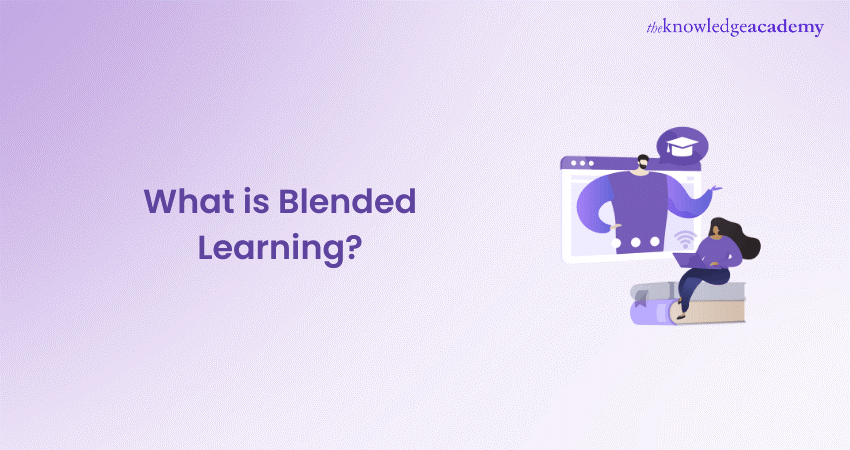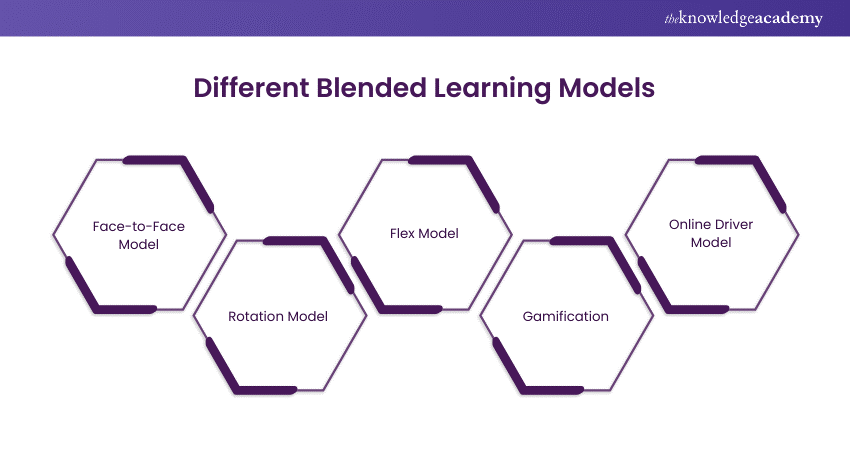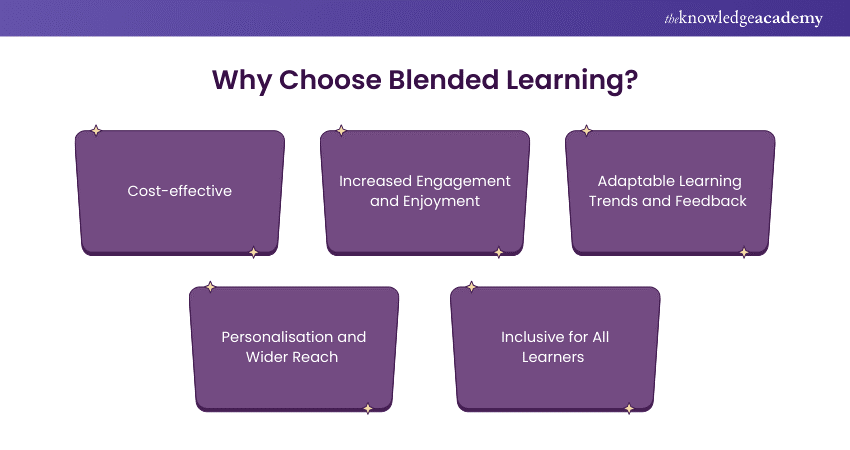We may not have the course you’re looking for. If you enquire or give us a call on +1800812339 and speak to our training experts, we may still be able to help with your training requirements.
Training Outcomes Within Your Budget!
We ensure quality, budget-alignment, and timely delivery by our expert instructors.

Have you ever enrolled in an online course? If yes, Blended Learning is an old buzzword for you. It emerged during the late 1990s and early 2000s and gradually gained wide acceptance for its integration of online and interactive classroom learning and live lecturers into a single curriculum.
But What is Blended Learning exactly? Is it completely online? Does it have any implications, or should we choose this mode of learning?
In this blog, we'll discuss this topic in detail to help you understand the different models associated with Blended Learning and explain why you should consider it worthwhile. So, wasting no time, let's get started!
Table of Contents
1) What is Blended Learning?
2) Different Blended Learning Models
3) Why Choose Blended Learning?
4) How to Implement Blended Learning
5) Advantages of Blended Learning
6) Challenges of Blended Learning
7) Conclusion
What is Blended Learning?
Blended Learning is a hybrid mode of learning that leverages the benefits of self-paced online learning and live interactive classrooms with faculty members.
For example, learners watch recorded courses online and complete digital assignments independently. Following that, they can attend week-in-person classes for discussions, hands-on experiments, and group activities.
Blended Learning gained widespread popularity in the late 1990s, when the Internet, especially the Yahoo search engine, was about to revolutionise global industries. With time, learners realised the significance of online learning owing to platforms like YouTube. They started learning things online and blended them with their traditional classroom experience to better understand concepts.
Different Blended Learning Models
Blended Learning has different models that help learners learn conveniently and comfortably. We have elaborated on these models in detail.

1) Face-to-Face Model: This model combines the value of traditional instructor-led sessions with digital resources. This allows learners to learn at their own pace while still gaining advantages from in-person interactions.
2) Rotation Model: The Rotation model allows learners to alternate between different learning activities, such as online modules and hands-on practice.
3) Flex Model: The Flex model offers personalised learning paths through a Learning Management System (LMS), where instructors act as the mentors.
4) Gamification: Gamification introduces game-like elements, such as points and levels, to enhance engagement and motivation.
5) Online Driver Model: The Online Driver model is entirely self-directed. It enables learners to progress through digital content independently while maintaining instructor interactions through online communication.
Why Choose Blended Learning?
There are several reasons to choose Blended Learning. It offers cost-friendliness, interactive experiences, et cetera. Below, we have described those reasons in pointers:

1) Cost-Effective
Blended Learning is comparatively cheaper than traditional classes, as it eliminates the costs associated with travelling and buying textbooks.
2) Increased Engagement and Enjoyment
It has numerous interactive features and a curriculum that helps learners gain valuable practical insights from real professionals during the course.
3) Adaptable Learning Trends and Feedback
Teachers and lecturers can quickly refine their course content based on the student's feedback after the lectures.
4) Personalisation and Wider Reach
Learners can learn at their own pace and access the material from anywhere.
5) Inclusive for All Learners
Blended Learning is adaptable to all learners' learning models and styles, making education accessible to everyone.
How to Implement Blended Learning?
Blended Learning has various implementation steps, which make it highly systematic and seamless and allow you to get the most out of the course. Here’re the ways to implement the Blended Learning model.
Step 1: Define Your Blended Learning Goals
Start by assessing what you want to achieve through Blended Learning. Is it to make the classes flexible for learners or enhance the profitability of the courses by integrating more learners?
Step 2: Select an Appropriate Model
After deciding on your goals, you need to choose the model that best fits the context. Prominent examples include rotation or flipped classroom models.
Step 3: Equip Yourself with the Right Tools
Post that, you need to gain accessibility to various tools like Content Management Systems (CMS) and content creation software to create the curriculum and deliver and track your courses effectively. Make sure you have done enough groundwork to assess the authenticity and credibility of the course, beforehand.
Step 4: Reimagine the Learning Environment
After designing the curriculum, try to make it interactive and engaging, which will support your chosen model and enhance the learning experience.
Step 5: Launch and Allow Time for Adjustment
Launch the course for the learners. Be patient and make adjustments as feedback. Remember, success takes time!
Captivate customers with powerful presentations- join our Presenting With Impact Training today!
Advantages of Blended Learning
The advantages of Blended Learning are described below:
1) Flexibility and Convenience: Blended Learning combines online and in-person methods, allowing learners to learn at their own pace while still having access to direct support from instructors. This balance helps accommodate different learning styles and schedules, making education more accessible.
2) Increased Engagement and Retention: Interactive online content, such as videos and quizzes, keeps learners interested and reinforces their understanding. When combined with face-to-face discussions and activities, it deepens comprehension and application of knowledge.
3) Cost-Effectiveness: Blended Learning reduces expenses related to classroom materials and travel. Educational institutions can divide resources more efficiently, by investing in high-quality digital tools and technologies instead of traditional costs.
4) Collaboration and Personalised Learning: Blended Learning fosters collaboration and personalised learning. Teachers can use data from online activities to identify areas where learners struggle and tailor their support accordingly. This combination of individualised Attention Management and collaborative projects enhances the overall learning experience.
Transform raw data into insights with our Data Analysis Skills Course- join now!
Challenges of Blended Learning
Though interactive, flexible, and adaptable, Blended Learning comes with its own sets of challenges. Here, we have described those challenges below:
1) Digital Divide: Not all learners have steady access to technology or a good internet connection, which creates gaps in learning and limits participation, especially in underserved communities.
2) Teacher Training and Support: Educators may struggle to adapt their teaching methods to integrate both online and offline elements effectively, leading to difficulties in maintaining consistency and quality across different delivery modes.
3) Student Engagement: Learners can become disengaged or distracted during online sessions, hindering the effectiveness of Blended Learning. Ensuring active participation requires careful planning and the use of interactive tools to keep learners motivated.
4) Time Management and Organisation: Balancing online and in-person components can be complex for both teachers and learners. Without proper planning and clear expectations, the learning experience may become disjointed, affecting overall outcomes.
Develop attention for peak productivity with our Attention Management Training – register today!
Conclusion
We hope you now understand What is Blended Learning. Blended Learning is a hybrid education that incorporates the flexibility of online education with the engagement of traditional classrooms. By adapting to various learning needs, you can gain accessibility and effectiveness in your learning experience. Moreover, implementing it effectively requires overcoming challenges which need to be overcome like technology access and maintaining student engagement.
Transform ambitions into achievements with our Motivation And Goal Setting Training – sign up now!
Frequently Asked Questions

The main idea behind Blended Learning is to combine the benefits of online digital media with traditional classroom methods, making it flexible and engaging. Moreover, it allows learners to learn independently while leveraging in-person interactions.

Yes, Blended Learning is often considered better than entirely online learning. The reason behind this is the flexibility of digital content combined with the personal interaction of in-person classes.

The Knowledge Academy takes global learning to new heights, offering over 30,000 online courses across 490+ locations in 220 countries. This expansive reach ensures accessibility and convenience for learners worldwide.
Alongside our diverse Online Course Catalogue, encompassing 19 major categories, we go the extra mile by providing a plethora of free educational Online Resources like News updates, Blogs, videos, webinars, and interview questions. Tailoring learning experiences further, professionals can maximise value with customisable Course Bundles of TKA.

The Knowledge Academy’s Knowledge Pass, a prepaid voucher, adds another layer of flexibility, allowing course bookings over a 12-month period. Join us on a journey where education knows no bounds.

The Knowledge Academy offers various Presentation Skills, including Blended Learning Essentials, Presenting with Impact Training Course, and Data Analysis Skills Training. These courses cater to different skill levels, providing comprehensive insights into Key Elements of Presentation to Make it Impactful.
Our Business Skills Blogs cover a range of topics related to professional development, offering valuable resources, best practices, and industry insights. Whether you are a beginner or looking to advance your business skills, The Knowledge Academy's diverse courses and informative blogs have got you covered.
Upcoming Business Skills Resources Batches & Dates
Date
 Blended Learning Essentials
Blended Learning Essentials
Fri 24th Jan 2025
Fri 21st Mar 2025
Fri 2nd May 2025
Fri 27th Jun 2025
Fri 29th Aug 2025
Fri 3rd Oct 2025
Fri 5th Dec 2025







 Top Rated Course
Top Rated Course



 If you wish to make any changes to your course, please
If you wish to make any changes to your course, please


